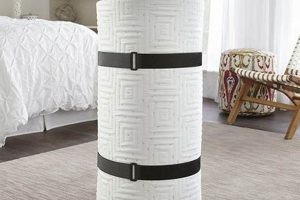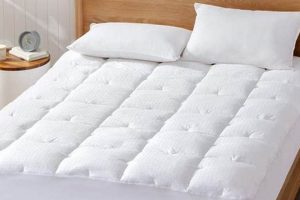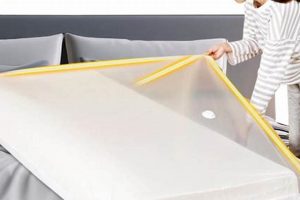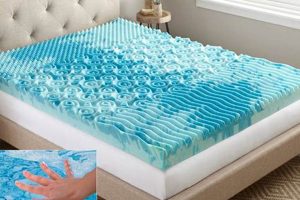A specialized covering designed to encase both a mattress and an added layer of padding, often elasticized around the edges, ensures a snug fit. This type of bedding component is essential for protecting and maintaining the integrity of both the underlying mattress and the additional comfort layer placed on top.
The utilization of such a covering offers several advantages. It safeguards the mattress and the additional layer from dirt, stains, and wear, prolonging their lifespan. Furthermore, it provides a smooth and secure surface, preventing the topper from shifting during use and enhancing overall sleep comfort. Historically, similar coverings have been used to protect mattresses from various environmental factors, evolving with the advent of modern materials and manufacturing techniques to address the specific needs of layered bedding systems.
This article will delve into various aspects of these coverings, including material selection, sizing considerations, maintenance practices, and factors to consider when choosing the most appropriate type for specific needs and preferences.
Selection and Use Guidance
The following provides pertinent guidance for selecting and effectively utilizing coverings designed for mattresses and supplementary layers. Adherence to these recommendations can optimize comfort, prolong product lifespan, and ensure proper hygiene.
Tip 1: Material Selection: Prioritize breathable fabrics such as cotton or bamboo. These materials facilitate air circulation, minimizing heat retention and promoting a more comfortable sleep environment. Synthetic materials may be less breathable and potentially contribute to overheating.
Tip 2: Correct Sizing: Accurate measurement of both the mattress and the additional layer is critical. The chosen covering must accommodate the combined thickness of both to ensure a secure and wrinkle-free fit. Insufficient depth can result in the covering detaching during use.
Tip 3: Secure Fit: Opt for deep-pocket designs with robust elastic edging. This feature ensures that the covering remains firmly in place, preventing slippage and maintaining a smooth sleeping surface. Examine the elastic for quality and durability.
Tip 4: Regular Cleaning: Frequent laundering, typically every one to two weeks, is essential for hygiene. Follow the manufacturer’s instructions for washing and drying to prevent damage or shrinkage. Consider using a gentle detergent to maintain fabric integrity.
Tip 5: Protection Against Allergens: Individuals with allergies should consider hypoallergenic materials that resist dust mites and other allergens. Regularly washing the covering at a high temperature can further reduce allergen levels.
Tip 6: Consider Thread Count: For cotton options, a higher thread count generally indicates a softer and more durable fabric. However, prioritize the type of cotton (e.g., Egyptian, Pima) over thread count alone.
Tip 7: Check for Shrinkage: Be aware that some materials are prone to shrinkage after washing. Pre-shrinking treatments or selecting larger sizes can mitigate this issue. Always consult the care label before laundering.
Selecting an appropriate covering and adhering to proper maintenance practices are crucial for maximizing the benefits and longevity of layered bedding systems. These steps contribute to a more comfortable, hygienic, and restful sleep experience.
The subsequent sections will address specific product types and advanced considerations for optimizing sleep quality.
1. Material Breathability
Material breathability significantly impacts the comfort and hygiene of coverings used for mattresses and their supplementary layers. The ability of the fabric to allow air circulation affects temperature regulation, moisture management, and overall sleep quality.
- Temperature Regulation
Breathable materials, such as cotton or linen, facilitate the dissipation of body heat. This prevents overheating during sleep, which can lead to restlessness and discomfort. Conversely, non-breathable materials trap heat, creating an uncomfortably warm sleep environment.
- Moisture Management
Breathable fabrics wick away moisture from the body, preventing the buildup of sweat. This reduces the risk of skin irritation and the growth of bacteria and mold within the bedding. Effective moisture management contributes to a more hygienic sleep surface.
- Air Circulation and Ventilation
Adequate air circulation prevents the stagnation of air between the sleeper and the mattress, promoting a fresher and more comfortable feel. This is particularly important when using additional layers, as they can restrict airflow if the covering is not sufficiently breathable.
- Material Composition and Weave
The specific fibers and weave pattern of the fabric determine its breathability. Natural fibers generally offer better breathability compared to synthetic fibers. Looser weaves allow for greater airflow compared to tighter weaves. Therefore, selecting materials with appropriate fiber composition and weave is critical for optimal breathability.
In summary, material breathability is a critical factor when selecting coverings for mattresses and supplementary layers. It directly affects temperature regulation, moisture management, and air circulation, all of which contribute to a more comfortable and hygienic sleep environment. The choice of material should prioritize breathability to maximize the benefits of the overall bedding system.
2. Proper dimensions
The precise measurements of a covering designed for both a mattress and an additional layer are paramount to its functionality. Inadequate dimensions can compromise the integrity of the sleep surface and diminish overall comfort, highlighting the critical need for accuracy.
- Accurate Depth Measurement
The depth of the covering, accommodating the combined thickness of the mattress and additional layer, is a primary consideration. Insufficient depth results in the covering pulling away from the mattress corners, leading to an uneven sleep surface. Conversely, excessive depth can create looseness, resulting in bunching and discomfort.
- Length and Width Precision
Length and width dimensions must precisely match those of the mattress and additional layer. Deviations in these measurements can lead to either stretching and potential tearing of the fabric or, conversely, a loose fit that allows the underlying components to shift. Standard mattress sizes dictate corresponding standard covering sizes, but variations in manufacturer dimensions necessitate verification.
- Elastic Band Considerations
The elast
ic band, typically located along the perimeter of the covering, is responsible for maintaining a secure fit. The length and elasticity of this band must be appropriately calibrated to the dimensions of the mattress and additional layer. An insufficiently strong or short elastic band will fail to adequately secure the covering, while an excessively strong or long band may cause undue stress on the fabric. - Impact on Topper Performance
An ill-fitting covering can directly impact the performance of the additional layer. Shifting or bunching caused by improper dimensions can negate the intended benefits of the layer, such as pressure relief or temperature regulation. A correctly sized covering ensures that the layer remains properly positioned, allowing it to function as designed.
The interconnectedness of these dimensional facets underscores the importance of selecting coverings with accurate measurements. Precise adherence to specified dimensions guarantees a secure, comfortable, and functional sleep surface, optimizing the benefits of both the mattress and its additional layer.
3. Elastic durability
The longevity and effectiveness of a covering designed for mattresses and supplementary layers are intrinsically linked to the durability of its elastic components. The elastic is responsible for maintaining tension and ensuring a secure fit, and its degradation directly impacts the covering’s functionality.
- Material Composition and Degradation
The composition of the elastic material is a primary determinant of its lifespan. Natural rubber elastics, while offering initial elasticity, are susceptible to degradation from oxidation, heat, and oils. Synthetic elastics, such as those made from polyester or nylon blends, generally exhibit greater resistance to these factors and therefore offer improved durability. However, even synthetic elastics can degrade over time due to repeated stretching and laundering.
- Construction and Stitching Techniques
The manner in which the elastic is integrated into the covering significantly influences its durability. Elastics that are simply stitched onto the edge of the fabric are prone to separation and unraveling, particularly under stress. Encasing the elastic within a fabric channel or employing reinforced stitching techniques distributes the stress more evenly, reducing the likelihood of failure. The type of thread used for stitching also plays a role; stronger, more durable threads enhance the overall integrity of the elastic component.
- Resistance to Laundering and Wear
Regular laundering subjects the elastic to repeated stress, including stretching, exposure to heat and detergents, and abrasion. Elastics that are not designed to withstand these conditions will quickly lose their elasticity and structural integrity. Similarly, continuous use and friction against the mattress can accelerate wear and tear. Selecting coverings with elastic that is specifically treated for enhanced resistance to laundering and wear is crucial for maintaining long-term performance.
- Impact on Fit and Functionality
The degradation of the elastic directly affects the covering’s ability to maintain a secure and snug fit. As the elastic loses its elasticity, the covering becomes prone to slipping, bunching, and wrinkling. This not only compromises comfort but also reduces the protective function of the covering, exposing the mattress and additional layer to dirt, stains, and wear. Furthermore, a loose-fitting covering can interfere with the intended performance of the additional layer, diminishing its pressure-relieving or temperature-regulating properties.
The correlation between elastic durability and the overall effectiveness of these coverings is undeniable. Prioritizing coverings with high-quality elastic components and implementing proper care practices ensures a secure fit, prolonged product lifespan, and optimized performance of both the mattress and its supplementary layer.
4. Secure fit
A secure fit is a critical attribute of a covering specifically designed for a mattress and a supplementary layer because it directly affects comfort, hygiene, and the lifespan of both components. The absence of a secure fit results in slippage, bunching, and displacement of the covering, negating its intended protective and functional roles. For instance, a loosely fitted covering cannot effectively shield the mattress and its additional layer from dust, allergens, and spills, thereby compromising hygiene and potentially reducing the lifespan of the bedding materials. Moreover, slippage can disrupt sleep patterns, as the sleeper experiences discomfort and the need to readjust the bedding frequently.
The secure fit is achieved through several design elements, including precise dimensional accuracy, deep pockets to accommodate the combined thickness of the mattress and additional layer, and robust elastic edging. A covering that accurately matches the dimensions of the bedding components ensures that the fabric is taut and evenly distributed, preventing wrinkles and folds. Deep pockets provide sufficient depth to encompass the combined thickness, maintaining a firm grip on the mattress corners. High-quality elastic edging, typically constructed from durable synthetic materials, provides consistent tension, preventing the covering from riding up or slipping off during use. Cases exist where consumers have purchased coverings marketed as “deep pocket” but lacking sufficient depth or elastic strength, leading to constant readjustment and dissatisfaction. Properly designed and manufactured covering, conversely, remains securely in place throughout the night, minimizing disturbance and maximizing comfort.
In summary, a secure fit is not merely a desirable feature but an essential component of these coverings. It is directly linked to the protective function, comfort, and overall performance of the bedding system. Challenges in achieving a secure fit arise from variations in mattress and additional layer dimensions, as well as inconsistencies in manufacturing standards. A thorough understanding of the factors contributing to a secure fit and careful consideration of product specifications are paramount in selecting coverings that provide long-lasting protection and optimal sleep quality.
5. Cleaning frequency
The frequency with which coverings designed for mattresses and supplementary layers are cleaned is directly correlated to hygiene, allergen control, and the overall lifespan of the bedding components. Infrequent cleaning allows the accumulation of dust mites, dead skin cells, body oils, and other contaminants, creating an environment conducive to bacterial growth and allergic reactions. This accumulation compromises the cleanliness of the sleeping surface and can exacerbate respiratory issues or skin irritations. For instance, individuals with dust mite allergies often experience worsened symptoms if bedding is not regularly laundered. Cleaning frequency, therefore, is not merely a matter of aesthetic preference but a critical determinant of health and hygiene within the sleep environment. The type of material the shee
ts are made of must be considered as well when establishing washing schedule.
The practical implications of adhering to recommended cleaning schedules extend to the longevity of both the mattress and the supplementary layer. Accumulated contaminants can degrade fabric fibers, leading to premature wear and tear. Body oils, in particular, can penetrate the fabric and damage the underlying materials. Regular cleaning removes these contaminants, preserving the integrity of the materials and extending their useful life. Furthermore, cleaning protocols should be tailored to the specific materials of the covering. High temperatures can damage certain fabrics, while harsh detergents can strip away natural oils, affecting the fabric’s softness and breathability. Therefore, understanding the material composition and following manufacturer-recommended cleaning instructions are essential for maintaining the covering’s performance and appearance over time.
In summary, the correlation between cleaning frequency and the overall quality of a mattress and supplementary layer covering is undeniable. Maintaining a regular cleaning schedule is essential for promoting hygiene, controlling allergens, and preserving the longevity of the bedding components. Challenges in implementing optimal cleaning practices often stem from a lack of awareness regarding the potential health risks associated with infrequent laundering or from a misunderstanding of proper cleaning techniques. By prioritizing regular cleaning and adhering to manufacturer guidelines, individuals can significantly improve the comfort, hygiene, and lifespan of their bedding system.
Frequently Asked Questions
The following section addresses common inquiries concerning coverings designed for both mattresses and supplementary layers. The information presented aims to clarify practical considerations and inform purchasing decisions.
Question 1: What constitutes a suitable material for a covering used with a mattress and an additional layer?
Optimal materials prioritize breathability and durability. Cotton, linen, and bamboo-derived fabrics are commonly recommended due to their ability to facilitate air circulation and manage moisture. Synthetic blends can offer enhanced durability but may compromise breathability. Material selection should consider individual preferences and potential sensitivities to allergens.
Question 2: How does one determine the appropriate size for a covering of this type?
Accurate measurement is paramount. The depth of the covering must accommodate the combined thickness of the mattress and the additional layer. Length and width dimensions should precisely match those of the underlying components. Manufacturers typically provide size charts that should be consulted prior to purchase.
Question 3: What factors contribute to the secure fit of such a covering?
A secure fit is contingent upon precise dimensional accuracy, deep pockets designed to encompass the combined thickness of the mattress and the supplementary layer, and robust elastic edging. The elastic should maintain consistent tension without undue stretching or slippage. Reinforced stitching techniques can enhance the durability of the elastic component.
Question 4: How frequently should a covering designed for a mattress and an additional layer be cleaned?
Regular laundering, typically every one to two weeks, is recommended for hygiene purposes. More frequent cleaning may be necessary for individuals with allergies or sensitivities. Manufacturer-recommended cleaning instructions should be followed to prevent damage to the fabric.
Question 5: Can the use of a covering impact the performance of the additional layer?
Yes. An ill-fitting covering can compromise the effectiveness of the supplementary layer. Slippage, bunching, or wrinkles can negate the intended benefits, such as pressure relief or temperature regulation. A properly sized and securely fitted covering ensures that the additional layer functions as designed.
Question 6: What are the potential consequences of neglecting proper maintenance of such a covering?
Failure to maintain the covering can result in the accumulation of dust mites, allergens, and bacteria, compromising hygiene and potentially exacerbating respiratory issues or skin irritations. Over time, accumulated contaminants can degrade fabric fibers, reducing the covering’s lifespan and diminishing its protective function.
Understanding these key points is crucial for making informed decisions about selecting and maintaining coverings for mattresses and supplementary layers.
The subsequent section will address advanced considerations for optimizing sleep quality.
Conclusion
This article has explored the critical facets of a fitted sheet for mattress topper, emphasizing material selection, dimensional accuracy, elastic durability, secure fit, and cleaning frequency. Each aspect plays a vital role in maintaining hygiene, ensuring comfort, and prolonging the lifespan of both the mattress and its supplementary layer. Proper understanding of these factors is paramount for informed purchasing decisions.
The selection and maintenance of a fitted sheet for mattress topper directly impacts the quality of sleep and the overall health of the sleeping environment. Continued vigilance in adhering to recommended practices will optimize the performance and longevity of this essential bedding component. Further research and technological advancements may yield innovative materials and designs, ultimately enhancing the consumer experience.


![Best Mattress Firm Mattress Topper: [Guide] Your Sleep Upgrade! Organic & Natural Mattress Buyer’s Guide: Non-Toxic Sleep Solutions Best Mattress Firm Mattress Topper: [Guide] Your Sleep Upgrade! | Organic & Natural Mattress Buyer’s Guide: Non-Toxic Sleep Solutions](https://mattressworldpa.com/wp-content/uploads/2025/07/th-5922-300x200.jpg)




